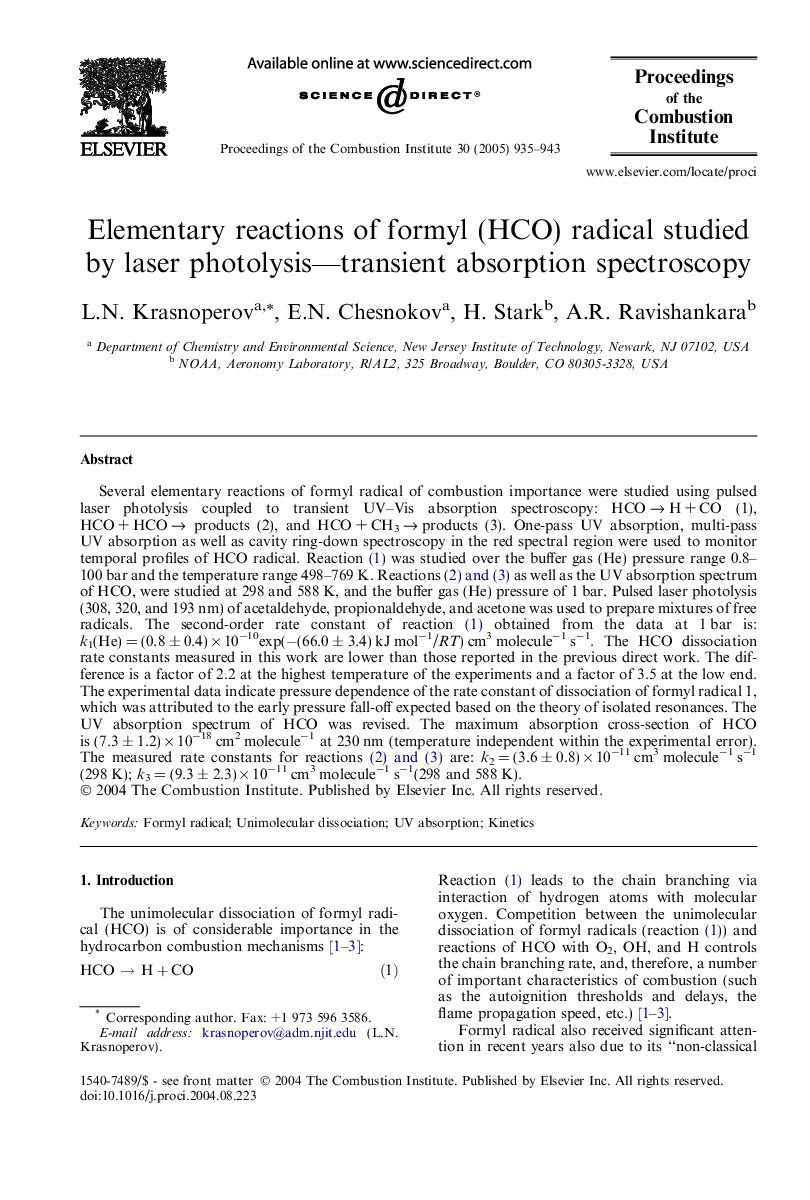| کد مقاله | کد نشریه | سال انتشار | مقاله انگلیسی | نسخه تمام متن |
|---|---|---|---|---|
| 9637421 | 1427931 | 2005 | 9 صفحه PDF | دانلود رایگان |
عنوان انگلیسی مقاله ISI
Elementary reactions of formyl (HCO) radical studied by laser photolysis-transient absorption spectroscopy
دانلود مقاله + سفارش ترجمه
دانلود مقاله ISI انگلیسی
رایگان برای ایرانیان
کلمات کلیدی
موضوعات مرتبط
مهندسی و علوم پایه
مهندسی شیمی
مهندسی شیمی (عمومی)
پیش نمایش صفحه اول مقاله

چکیده انگلیسی
Several elementary reactions of formyl radical of combustion importance were studied using pulsed laser photolysis coupled to transient UV-Vis absorption spectroscopy: HCO â H + CO (1), HCO + HCO â products (2), and HCO + CH3 â products (3). One-pass UV absorption, multi-pass UV absorption as well as cavity ring-down spectroscopy in the red spectral region were used to monitor temporal profiles of HCO radical. Reaction (1) was studied over the buffer gas (He) pressure range 0.8-100 bar and the temperature range 498-769 K. Reactions (2a), (2b), (2c), (3a), (3b) as well as the UV absorption spectrum of HCO, were studied at 298 and 588 K, and the buffer gas (He) pressure of 1 bar. Pulsed laser photolysis (308, 320, and 193 nm) of acetaldehyde, propionaldehyde, and acetone was used to prepare mixtures of free radicals. The second-order rate constant of reaction (1) obtained from the data at 1 bar is: k1(He) = (0.8 ± 0.4) Ã 10â10exp(â(66.0 ± 3.4) kJ molâ1/RT) cm3 moleculeâ1 sâ1. The HCO dissociation rate constants measured in this work are lower than those reported in the previous direct work. The difference is a factor of 2.2 at the highest temperature of the experiments and a factor of 3.5 at the low end. The experimental data indicate pressure dependence of the rate constant of dissociation of formyl radical 1, which was attributed to the early pressure fall-off expected based on the theory of isolated resonances. The UV absorption spectrum of HCO was revised. The maximum absorption cross-section of HCO is (7.3 ± 1.2) Ã 10â18 cm2 moleculeâ1 at 230 nm (temperature independent within the experimental error). The measured rate constants for reactions (2a), (2b), (2c), (3a), (3b) are: k2 = (3.6 ± 0.8) Ã 10â11 cm3 moleculeâ1 sâ1 (298 K); k3 = (9.3 ± 2.3) Ã 10â11 cm3 moleculeâ1 sâ1(298 and 588 K).
ناشر
Database: Elsevier - ScienceDirect (ساینس دایرکت)
Journal: Proceedings of the Combustion Institute - Volume 30, Issue 1, January 2005, Pages 935-943
Journal: Proceedings of the Combustion Institute - Volume 30, Issue 1, January 2005, Pages 935-943
نویسندگان
L.N. Krasnoperov, E.N. Chesnokov, H. Stark, A.R. Ravishankara,